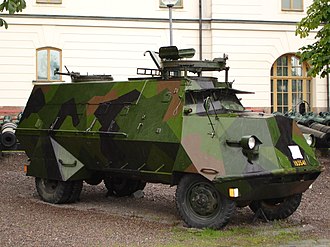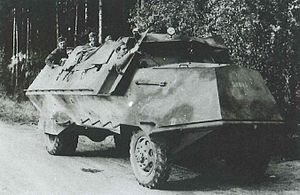Tgb m/42 KP
| Terrängbil m/42 KP | |||
|---|---|---|---|
 Final terrängbil m/42 KP model: tgb m/42 D SKPF, at the Swedish Army Museum in Stockholm. | |||
| Type | Infantry fighting vehicle | ||
| Place of origin | |||
| Service history | |||
| In service | 1944 – 1970: Volvo KP 1944 – 2004: Scania KP | ||
| Used by | |||
| Wars | Congo Crisis | ||
| Production history | |||
| No. built |
| ||
| Variants | See variants | ||
| Specifications | |||
| Mass |
| ||
| Length |
| ||
| Width |
| ||
| Height |
| ||
| Crew | 3: commander, driver, gunner | ||
| Passengers | 16: fully equipped soldiers | ||
| Armor | 8 to 20 mm (0.31 in to 0.79 in) | ||
Main armament | Initially unarmed 1 × single 8 mm ksp m/39 (1940s) 1 × twin 8 mm ksp m/36 lv dbl (1956) 2 × single 7.62 mm ksp 58B (1980s) 1 × single 12.7 mm DShKM (Baltic states) | ||
Secondary armament | 6 × smoke grenade discharger (1980s) | ||
| Engine |
| ||
| Payload capacity |
| ||
| Drive |
| ||
| Transmission |
| ||
| Fuel capacity | 110 l (29 US gal) | ||
Operational range |
| ||
| Maximum speed |
| ||
| References | [1][2][3] | ||
Terrängbil m/42 KP (tgb m/42 KP), full name: terrängbil m/42 Karosseri Pansar ("terrain car model 1942 Coachwork Armour"),[a] commonly nicknamed "KP-car" (Swedish: KP-bil), was a Swedish infantry fighting vehicle[b] developed during World War II.[1] It is at its core a flatbed truck fitted with an armoured body elongated over and around the bed with a troop transport compartment behind the cabin for mechanized infantry (Swedish: pansarskytte).
Two base variants existed based on the chassis: terrängbil m/42 "SKP" ("Scania Karosseri Pansar") based on a Scania chassis and terrängbil m/42 "VKP" ("Volvo Karosseri Pansar") based on a Volvo chassis.[1]
Technical description
Body
The armoured body featured 8 to 20 mm (0.31 in to 0.79 in) thick welded sloped armour all around, making it effectively bullet proof. The troop compartment originally lacked a fixed roof and had partially open sides meant for the infantry to shoot from as part of its infantry fighting vehicle role. Instead of a fixed roof, the back end of the body had full height sides so a tarpaulin could be fitted over the troop compartment between the cabin and the back.[1]
In the 1980s, however, most remaining vehicles were updated with a new fully enclosed troop compartment with firing ports and a back door for fast disembarkment.[1]
Armament
While always intended for armament, featuring a round hatch sized hole on the cabin roof, the vehicles initially lacked any permanent such and the cabin roof hole was often bolted over with a metal plate.[1] One vehicle was early on at one point trialed with a 20 mm akan m/40 autocannon but the first standard armament was a single 8 mm ksp m/39 machine gun fitted in a rotating turret ring on top of the cabin sometime during the second half of the 1940s.[4]
In 1956, however, the existing vehicles received armament in the form of two 8 mm ksp m/36 lv dbl anti-aircraft machine guns in a twin-mount on the cabin roof.[1]
During the 1980s REMO-upgrade the ksp m/36 twin-mount was replaced with two 7.62 mm ksp 58B light machine guns in single mounts, one on the cabin roof and one at the back of the troop compartment roof.[1]
History
Swedish use
In 1941, when tanks were organised into a unit of their own, it was clear there was a desperate need for a troop carrier able to both keep up with the tanks and provide protection against artillery shrapnel and small-arms fire. Due to the war, there were no international suppliers to buy from, so the only option was to develop a domestic solution. AB Landsverk designed an IFV consisting of a chassis from a regular army lorry equipped with an armoured coachwork.
The armour-plates were made by Bofors, Landsverk, Bröderna Hedlund and Karlstads Mekaniska Werkstad and then delivered to Volvo or Scania-Vabis for final assembly on their chassis'. The Volvo versions, Tgb m/42 VKP had a fixed winch on the right side for towing the vehicle forward, while the Scania-Vabis, SKP, instead had a windlass on the left side which allowed towing both forwards and backwards. The first approved delivery was made in 1944, after some 38 vehicles had been failed due to tensions caused by welding the hardened steel. This was rectified by switching to a soft-hardened steel and then heating the completed body-work in purpose-built ovens to remove the tensions.
During the 1950s the vehicles were modified with a ring-mounting for a double machine gun on the cab roof and at that time the designations changed to Tgb m/42 VKPF and SKPF (F = Fordonsluftvärn, or vehicular anti-aircraft).
In the 1980s and 1990s, many surviving SKPFs of the Swedish Army were modified with armoured roofs and in many other ways, resulting in several new versions.
International use

The SKPF saw combat with Swedish UN forces during the Congo Crisis in the 1961–1964 period, while the VKPF was kept for domestic use. 15 SKPFs were also bought by the UN and used by the Indian and Irish battalions in Congo. After a number of KP gunners in Congo were shot in the waist, armour plating to cover the gap between the roof and the machine gun ring was added in sito.
A few left-behind UN SKPFs were reconditioned and used by the Congolese Army in 1964-65.
SKPFs were also deployed by United Nations Peacekeeping Force in Cyprus during the intercommunal violence in 1964, some being donated to the UN forces there.[5]
After the collapse of the Soviet Union, Estonia, Latvia and Lithuania received 10 SKPF each for a total of 30, some being modified to mount a 12.7 mm DShKM heavy machine gun over the cabin.[3]
Variants
|
|
REMO – 1980s
REMO = Renovation, Modifikation: 223 total (Scania KP only).
- Terrängbil m/42 D SKPF (tgb m/42 D SKPF) – closed roof with firing ports and back door, armed with two single-mount 7,62 mm ksp 58B light machine guns on the front and back end of the roof, six smoke grenade dischargers, spaced external front armour removed due to weight, new terrain wheels (wheelhouse reworked), servo brakes and new street legal lighting, 173 modified.
- Stabterrängbil m/42 A SKP (stabtgb m/42 A SKP) – Equal to the terrängbil m/42 D SKPF but intended as a command vehicle with internally integrated radios: three Ra 421, one Ra 195, + electronics, 16 modified.
- Sjukterrängbil 9521 A (sjtgb 9521 A) – military ambulance version of the terrängbil m/42 D SKPF, unarmed, 23 modified.
- Terrängbil m/42 E SKPF (tgb m/42 E SKPF) – coup defense version of the terrängbil m/42 D SKPF, one ksp 58B light machine gun in original m/36 twin-mount, 11 modified.
Footnotes
- ^ Name is formally "descriptive" and thus not spelled "capitalized" in the middle of a sentence.
- ^ Terrängbil m/42 KP is often called an armoured personnel carrier due to its wheeled chassis and machine gun armament. This is however incorrect as it is a purpose built infantry fighting vehicle meant to fight alongside its mechanized infantry in battle and also allowing them to fight from within the vehicle. See the Swedish IFV-article for more information on Swedish IFV-doctrine and definition: sv:pansarskyttefordon.
References
Notes
- ^ a b c d e f g h "Terrängbil m/42 KP". ointres.se. Retrieved 2021-11-15.
{{cite web}}: CS1 maint: url-status (link) - ^ "Terrängbil m/42 KP". gotlandsforsvarsmuseum.se. Gotlands Försvarsmuseum. Retrieved 2022-05-07.
- ^ a b "Svenska veteraner-Terrängbil M/42 KP". lantvarnet.wordpress.com. Lantvärnet. Retrieved 2022-05-07.
- ^ "Korpralskola vid P 4 i Skövde 1947-1948". digitaltmuseum.org. Korpralskolan. Retrieved 2022-07-04.
- ^ "KP-bilar".
Web sources
- "Terrängbil m/42 KP". ointres.se. Retrieved 2021-11-15.
{{cite web}}: CS1 maint: url-status (link) - "Terrängbil m/42 KP". gotlandsforsvarsmuseum.se. Retrieved 2022-05-07.
- "Svenska veteraner-Terrängbil M/42 KP". lantvarnet.wordpress.com. Retrieved 2022-05-07.
See also
BoilerPlate was here


